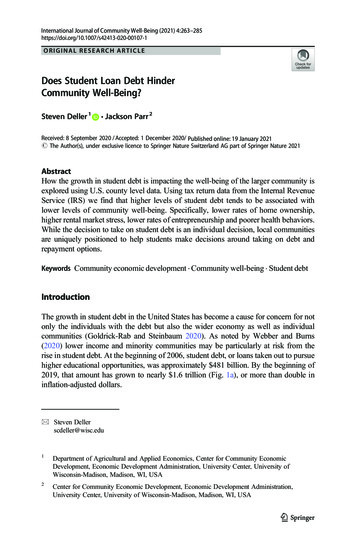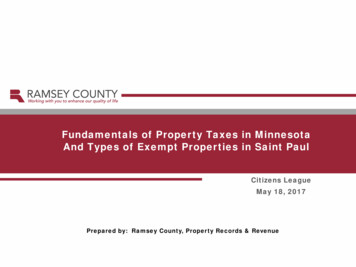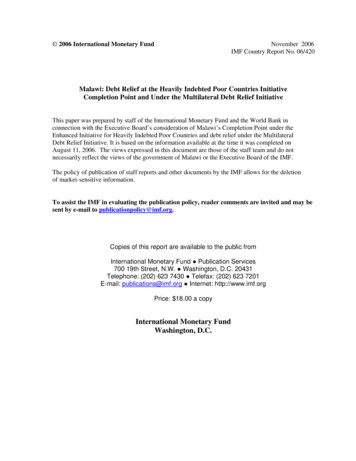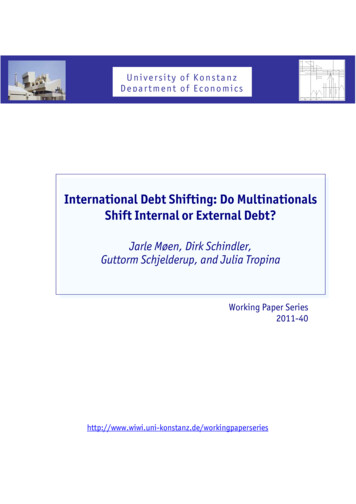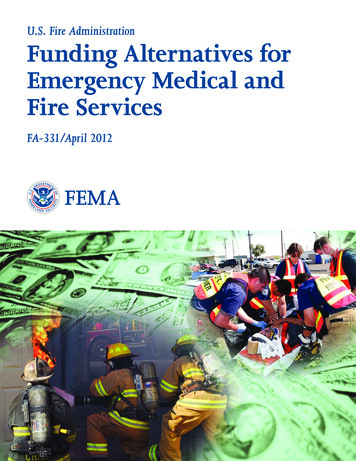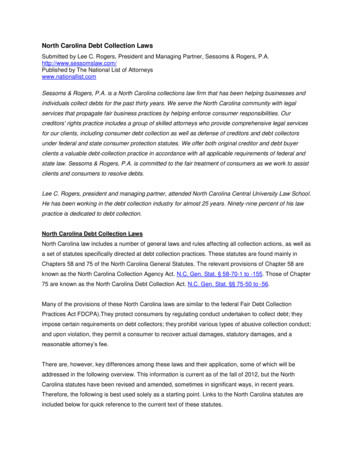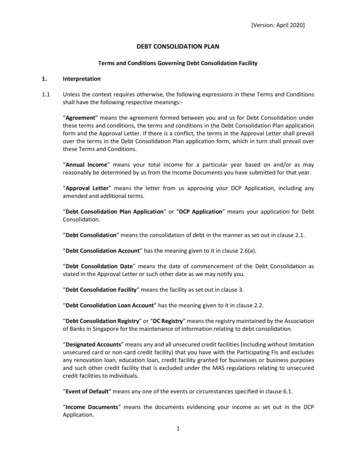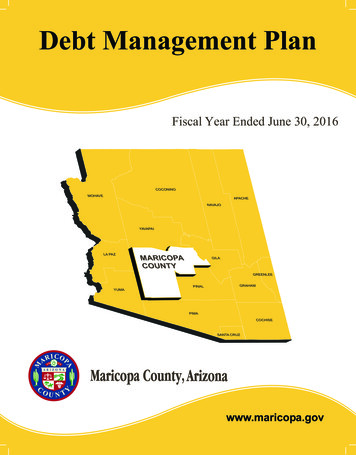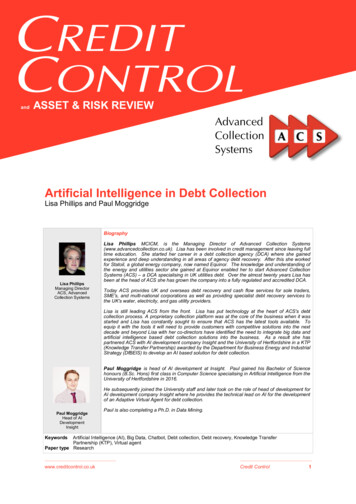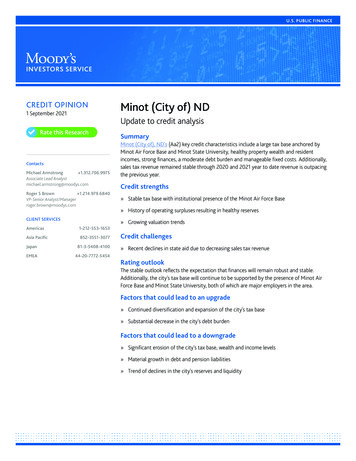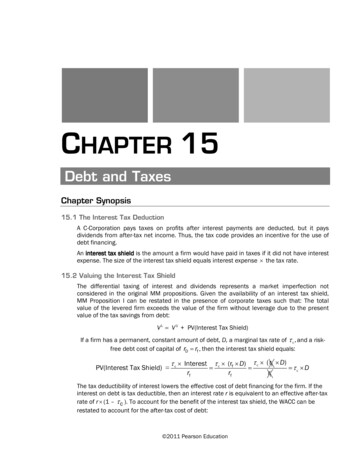
Transcription
CHAPTER 15Debt and TaxesChapter Synopsis15.1 The Interest Tax DeductionA C-Corporation pays taxes on profits after interest payments are deducted, but it paysdividends from after-tax net income. Thus, the tax code provides an incentive for the use ofdebt financing.An interest tax shield is the amount a firm would have paid in taxes if it did not have interestexpense. The size of the interest tax shield equals interest expense the tax rate.15.2 Valuing the Interest Tax ShieldThe differential taxing of interest and dividends represents a market imperfection notconsidered in the original MM propositions. Given the availability of an interest tax shield,MM Proposition I can be restated in the presence of corporate taxes such that: The totalvalue of the levered firm exceeds the value of the firm without leverage due to the presentvalue of the tax savings from debt:V L V U PV(Interest Tax Shield)If a firm has a permanent, constant amount of debt, D, a marginal tax rate of τ c , and a riskfree debt cost of capital of rD rf , then the interest tax shield equals:PV(Interest Tax Shield) τ c Interest τ c (rf D) τ c ( rf D)rf rf rf τc DThe tax deductibility of interest lowers the effective cost of debt financing for the firm. If theinterest on debt is tax deductible, then an interest rate r is equivalent to an effective after-taxrate of r (1 – τ c ). To account for the benefit of the interest tax shield, the WACC can berestated to account for the after-tax cost of debt: 2011 Pearson Education
174Berk/DeMarzo Corporate Finance, Second Editionrwacc EDrE rD (1 τ C ).E DE D15.3 Recapitalizing to Capture the Tax ShieldConsider a firm that has 20 million shares outstanding, a stock price of 15, no debt, and a35% tax rate. The firm has had consistently stable earnings and management believes thatthey can borrow as much as 100 million. They are considering a leveraged recapitalizationin which they would use the borrowed funds to repurchase 100 million/ 15 6.67 millionshares. They expect that the tax savings from this transaction will boost the stock price andbenefit shareholders.Without leverage, the firm’s market value is the value of its unlevered equity. Assuming thecurrent stock price is the fair price for the shares without leverage:V U (20 million shares) ( 15) 300 million.With 100 million in permanent debt, the present value of the firm’s future tax savings isτ c D 0.35( 100 million) 35 million and the levered firm value is:V L V U PV(Interest Tax Shield) 300 million 35 million 335 million.The equity value, net of the 100 million of debt, is:E V L D 335 million 100 million 235 million P 235 million 17.625.20 6.67Since the shares were repurchased at 15, the 13.33 million remaining shareholders get allof the 35 million tax shield, which equals 35 million/13.33 million 2.625 per share.More realistically, once investors know the recap will occur, the share price will riseimmediately to a level that reflects the 35 million value of the interest tax shield that thefirm will receive, 235 million/20 million 16.75 per share. The benefit of the interest taxshield now goes to all 20 million of the original shares outstanding for a total benefit of 1.75/share 20 million shares 35 million.15.4 Personal TaxesPersonal taxes may offset the corporate tax benefits of leverage. Investors are generallytaxed on interest income from debt and dividend income from a stock; they are also taxed oncapital gains when they sell a stock but may delay incurring those taxes indefinitely.Every 1 received after taxes by debt holders from interest payments costs equity holders 1 (1 – τ * ) on an after tax basis, in which τ * , the effective tax advantage of debt, equals:τ * (1 τ i ) (1 τ c )(1 τ e )(1 τ c )(1 τ e ) 1 (1 τ i )(1 τ i )where τ e is the personal tax rate on equity income and τ i is the personal tax rate on interestincome. Now, the tax shield in a year is τ * interest expense, and the value of a levered firmwith permanent debt isV L V U τ * D. 2011 Pearson Education
Berk/DeMarzo Corporate Finance, Second Edition175When there are no personal taxes, or when τ e τ i , then τ * τ C . However, when τ e τ i , asit is today, then τ * τ C and there is a tax benefits of leverage.15.5 Optimal Capital Structure with TaxesIn recent years, U.S. firms have shown a clear preference for debt as a source of externalfinancing. In fact, the overall net equity issues has been negative, meaning that the value ofshares that firms have bought back is greater than the value of the shares they have issued.Even though firms have not issued new equity, the market value of equity has risen over timesuch that average firm’s debt as a fraction of the firm’s value has remained reasonablystable at 35% to 40%. In 2005, debt accounted for about 36% of U.S firms’ capitalstructures; however, the use of debt varied significantly by industry. Firms in growthindustries like high technology carry very little debt, whereas airlines, automakers, andutilities, have high leverage ratios.There is no corporate tax benefit from incurring interest payments that exceed EBIT. In fact,because interest payments constitute a tax disadvantage at the investor level when τ i τ e ,investors will pay higher individual taxes with excess leverage, making them worse off. Thus,it is optimal to borrow until interest equals EBIT to take full advantage of the corporate taxdeduction of interest, but avoid the tax disadvantage of excess leverage at the personal level.Since there are other provisions in the tax laws for deductions and tax credits, such asdepreciation, investment tax credits, and operating loss carryforwards, some firms rely lessheavily on the interest tax shield. However, even after considering alternate tax shields, firmshave far less leverage than theory would predict at this point in the analysis. In the nextchapter, factors that may help explain such apparently suboptimal behavior, such asbankruptcy costs, are considered.Selected Concepts and Key TermsInterest Tax ShieldThe amount that a firm would have paid in taxes if it did not have interest expense. The sizeof the interest tax shield each period equals interest expense the tax rate.Concept Check Questions and Answers15.1.1. With corporate income taxes, explain why a firm’s value can be higher with leverage eventhough its earnings are lower.A firm can be better off even though its earnings are lower because the total amountavailable to all investors is higher with leverage. The value of a firm is the total amount itcan raise from all investors, not just equity holders. So, if the firm can pay out more in totalwith leverage, it will initially be able to raise more total capital.15.1.2. What is the interest tax shield?The interest tax shield is the gain to investors from the tax deductibility of interestpayments. It is the additional amount that a firm would have paid in taxes if it did not haveleverage. 2011 Pearson Education
176Berk/DeMarzo Corporate Finance, Second Edition15.2.1. With corporate taxes as the only market imperfection, how does the value of the firm withleverage differ from its value without leverage?The total value of the levered firm exceeds the value of the firm without leverage due to thepresent value of the tax savings from debt.15.2.2. How does leverage affect a firm’s weighted average cost of capital?Corporate taxes lower the effective cost of debt financing, which translates into a reductionin the weighted average cost of capital. The magnitude of the reduction in the WACC isproportional to the amount of debt financing. The higher the firm’s leverage, the more thefirm exploits the tax advantage of debt, and so the lower its WACC.15.3.1. How can shareholders benefit from a leveraged recap when it reduces the total value ofequity?Although a leveraged recap reduces the total value of equity, shareholders capture thebenefits of the interest tax shield upfront. The stock price rises at the announcement of therecap.15.3.2. How does the interest tax shield enter into the market value balance sheet?The total market value of a firm’s securities must equal the total market value of the firm’sassets. In the presence of corporate taxes, we must include the interest tax shield as oneof the firm’s assets on the market value balance sheet.15.4.1. Under current law (in 2009), why is there a personal tax disadvantage of debt?Just like corporate taxes, personal taxes reduce the cash flows to investors and diminishfirm value. Personal taxes thus have the potential to offset some of the corporate taxbenefits of leverage. Currently, in the United States and many other countries, interestincome is taxed more heavily than capital gains from equity.15.4.2. How does the personal tax disadvantage of debt change the value of leverage for the firm?Personal taxes offset some of the corporate tax benefits of leverage and thus reduce thevalue of leverage for the firm.15.5.1. How does the growth rate of a firm affect the optimal fraction of debt in the capitalstructure?The optimal fraction of debt, as a proportion of a firm’s capital structure, declines with thegrowth rate of the firm.15.5.2. Do firms choose capital structures that fully exploit the tax advantages of debt?The empirical results of international leverage indicate that firms do not fully exploit the taxadvantages of debt because the interest expense of the average firm is well below itstaxable incomeExamples with Step-by-Step SolutionsSolving ProblemsProblems using this chapter’s ideas often involve calculating the after-tax cost of debt, theafter-tax weighted-average cost of capital, the interest tax shield, and finding the presentvalue of the interest tax shield and the value of a levered firm. Applications includeconsidering the consequences on shareholder value of a leveraged recapitalization, which 2011 Pearson Education
Berk/DeMarzo Corporate Finance, Second Edition177involves issuing debt which is then used to repurchase shares. Problems may also involveconsidering the effects of personal taxes.Examples1. You are trying to decide whether your firm should use debt financing under differentassumptions regarding the amount of debt in its capital structure. The firm’s assets willgenerate an expected EBIT of 800,000 per year (beginning one year from today) inperpetuity. The firm will make no new capital or working capital investments and all assetsare fully depreciated. The assets have a beta of 1.5, the risk-free rate is 5%, and the marketrisk premium is 10%. You can issue bonds at par paying an annual coupon at a 5% annualrate. The corporate tax rate is 50%, and the firm has 100,000 shares outstanding.[A] What is the value of the firm with no debt? What is the stock value per share?[B] What is the value of the firm if it issues 1.5 million of debt and uses the proceeds torepurchase 75,000 shares for 20 (75,000 20 1.5 million)? What is the stockvalue per share? Should the firm issue the debt?Step 1. Determine the unlevered equity cost of capital.The equity cost of capital is E[Ri ] r f βiMkt (E[RMkt ] rf ) 5% 1.5(10%) 20%.Step 2. Determine the free cash flows of the unlevered firm.Since the firm will make no new investments and has no depreciation, FCF NI each year.EBIT 800,000 Tax @ 50%400,000Net income400,000Step 3. Determine the value of the unlevered firm.Since the cash flows are a perpetuity, PV FCF 400,000 2 millionr0.20Step 4. Determine the value per share.Value per share VU 2,000,000 20Shares Outstanding100,000Step 5. Determine the value of the levered firm.D(rD )(τ C )rD 1,500,000(0.05)(0.50) 2,000,000 2,750,0000.05V L V U PV(Tax shield) 2,000,000 Step 6. Determine the equity value per share.The total equity value is VL – D 2,750,000 – 1,500,000, and the number of sharesrepurchased is 1,500,000/ 20 75,000, so:Value per share 2,750,000 1,500,000 50.100,000 75,000 2011 Pearson Education
178Berk/DeMarzo Corporate Finance, Second EditionThus, the firm should issue the debt based on these assumptions because it leads to an 50 20 150%.increase in the share price of 202. Wrigley Inc. had 1 billion in EBITDA in 2006. The firm is unlevered and has a market valueof equity of 12 billion and a tax rate of 40%. Consider the effect on the value of the firm ofthe following debt issuances. Assume that all proceeds will be used to buy back stock.[A] Issuing 6 billion of 8% coupon rate 5-year bonds which repay the principal in 5 years.[B] Issuing 6 billion of 8% coupon rate permanent bonds.[C] Issuing 6 billion of 8% coupon rate bonds, with amount of bonds increasing by 5%every year forever.Step 1. Determine the value of the levered firm for the 5-year bonds.Since annual interest is 0.08( 6 billion) 480 million, the annual tax shield is 480 million 0.40 192 million for five years.1 1 V L V U PV(Interest Tax Shield) 12 billion 192 million 1 5 .08.08(1.08) 12 billion 0.8 billion 12.8 billionStep 2. Determine the value of the levered firm for the permanent bonds.Now, the 192 million tax shield is a perpetuity. 192 million V L V U PV(Interest Tax Shield) 12 billion .08 12 billion 2.4 billion 14.4 billionStep 3. Determine the value of the levered firm for the bonds that increase by 5% every yearforever.Now, the 14 million tax shield is the first cash flow in a growing perpetuity. 192 million V L V U PV(Interest Tax Shield) 12 billion .08 .05 12 billion 6.4 billion 18.5 billion3. Best Buy is equally likely to have EBIT this coming year of 1 billion, 1.5 billion, or 2 billion.Its corporate tax rate is 35%, and investors pay a 15% tax rate on income from equity and a30% tax rate on interest income.[A] What is the effective interest tax shield (considering both personal taxes and corporatetaxes) if interest expense is 500 million this year?[B] At what level of interest expense does the effective tax advantage of debt disappear?Step 1. Determine the effective tax rate if all of the interest will be used to shield taxes.τ* 1 (1 τ C )(1 τ e )1 τi 1 (1 0.35 )(1 0.15 )1 0.30 21.1%Step 2. Determine the effective tax shield if interest expense is 500,000.Tax shield τ * Interest expense 0.211 500,000 105,357 2011 Pearson Education
Berk/DeMarzo Corporate Finance, Second Edition179Step 3. Determine when the effective tax rate is negative by considering different levels ofinterest expense.Interest expense 500,000,000 1,000,000,000Probability of NI 01.01.0 1,500,000,0002 2,000,000,000133E[ τ C ]0.3500.3500.210.210.2330.070.117-0.07τ*So for an interest expense up to 1.5 billion, there is a tax advantage. For interest expenseover 1.5 billion, there is an expected effective tax disadvantage for debt financing.Questions and Problems1. A firm expects free cash flow of 10 million each year. Its corporate tax rate is 35%, and itsunlevered cost of capital is 10%. The firm also has outstanding debt of 35 million, and itexpects to maintain this level of debt permanently.[A] What is the firm’s value without leverage?[B] What is the firm’s value with the 35 million of debt?2. A firm is considering permanently adding 100 million of debt to its capital structure. Thecorporate tax rate is 35%.[A] Absent personal taxes, what is the value of the interest tax shield from the new debt?[B] If investors pay a tax rate of 40% on interest income, and a tax rate of 20% on incomefrom dividends and capital gains, what is the value of the interest tax shield from thenew debt?3. An unlevered firm has 50 million shares outstanding and a stock price of 20. The firm plansto unexpectedly announce that it will issue 500 million in 10% coupon rate debt financingand use the proceeds to repurchase shares. The debt level is expected to remain at thislevel. The tax rate is 35%.[A] What is the firm’s market value before the announcement?[B] What is the market value of the firm after the repurchase?[C] What is the share value after the repurchase assuming that the shares can berepurchased at 20 per share?4. Suppose the corporate tax rate is 35%, and investors pay a tax rate of 15% on income fromdividends or capital gains and a tax rate of 28% on interest income. Your firm plans to issue 1 billion in perpetual 10% coupon bonds. The firm has historically paid all net income out asdividends; however, in order to pay this interest expense, the firm will cut its dividend.[A] How much will bondholders receive after paying taxes on the interest they earn?[B] By how much will the firm need to cut its dividend each year to pay this interestexpense?[C] By how much will this cut in the dividend reduce equity holders’ annual after-taxincome?[D] How much less will the government receive in total tax revenues each year?[E] What is the effective tax advantage of debt with this amount of leverage?5. Your unlevered firm will have a certain EBIT every year of 80 million. Every year it will spend 10 million on capital expenditures, invest 10 million in net working capital, and have 28million in depreciation. The corporate tax rate is 35%, and the firm’s cost of capital is 11%.[A] If the firm’s free cash flow is expected to grow by 5% per year, what is the value of itsequity today? 2011 Pearson Education
180Berk/DeMarzo Corporate Finance, Second Edition[B]If the debt cost of capital is 10%, what amount of borrowing would maximize the valueof the firm? What would the value of the firm be then?Solutions to Questions and Problems1. [A][B]2. [A][B]3. [A][B]10 100 million0.10V L V U τ C D 100 0.35 30 110.5 millionVU PV(Interest Tax Shield) τ C D 35% 100 35 million.τ* 1 (1 0.35 )(1 0.20 ) 13.33%1 0.40PV(Interest Tax Shield) τC D 13.33% 100 13.33 millionVU 20 50 million 1 billionVL VU PV(Tax Shield) 1 billion 500 million(0.10)(0.35) 175 million0.10 1.175 billion.E VL – D 1.175 billion – 500 million 675 million500 million 25 million shares.They will repurchase 20 1.175 billion 500 million 27.The share price is thus 50 million 25 million[C]4. [A][B][C][D][E]5. [A] 100 million (1 – .28) 72 million each yearAn interest expense of 100 million per year reduces net income by 100(1 – .35) 65 million after corporate taxes. So, dividends will be 65 million less. 65 million dividend cut 65 (1 – .15) 55.25 million per year.Interest taxes .28 100 million 28 millionLess corporate taxes .35 100 million 35 millionLess dividend taxes .15 65 million 9.75 million Government tax revenues change by 28 – 35 – 9.75 – 16.75 million(1 0.35 )(1 0.15 )τ* 1 23.3%1 0.28FCF EBIT (1 τ ) Dep Capex ΔNWC 80 (1 0.35 ) 28 10 10 6060 1 billion0.11 0.05The firm can pay 80 million in interest, so it can borrow: 80 million 800 million at 10%.0.10 800 million(0.10)(0.35) 1.28 billionV L 1 billion 0.10VU E [B] 2011 Pearson Education
debt financing. An interest tax shield is the amount a firm would have paid in taxes if it did not have interest expense. The size of the interest tax shield equals interest expense the tax rate. 15.2 Valuing the Interest Tax Shield The differential taxing of interest and dividends represents a market imperfection not
